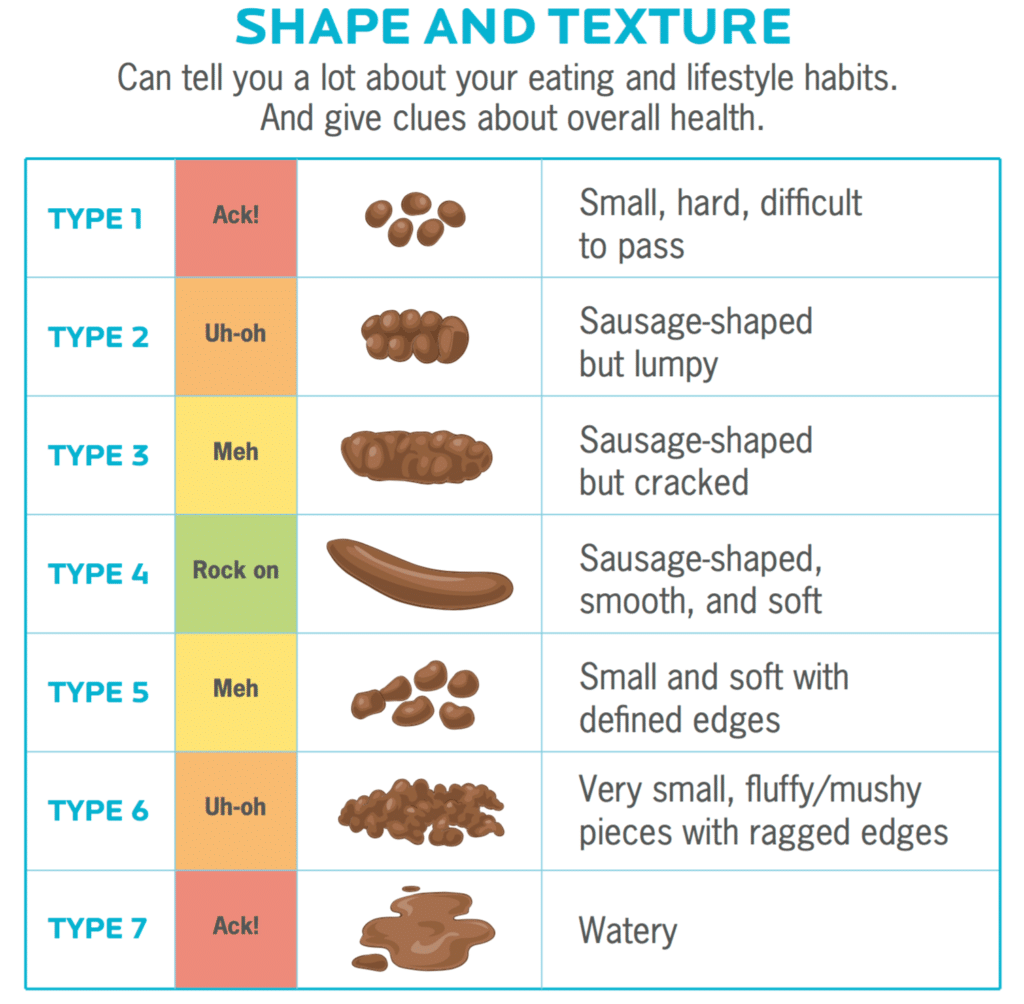Everything Comes Down To 💩 (Poop)

Do you all remember the show “Scrubs?” Probably one of my favorite shows and love watching it on Netflix when I don’t want to think.
If you have watched the show Scrubs, do you remember the musical production of, “Everything Comes Down to Poo?” If you have never watched Scrubs, let me introduce you to this show…
Okay, yes, this is a weird subject to be talking about, I get it. However, it’s very important to know what your poop says about you and your health, especially since it’s always the symptom of something bigger. By ignoring the obvious signs, you might be ignoring the message your body is trying to send, asking for help.
When it comes to our poop, there’s no globally accepted standards for what is normal, since normal is different for an individual. The frequency, texture, size, consistency, as well as the smell of it is normal for you, if that’s how it regularly comes out.
Also, in regards to how often is normal, it seems like we’ve all adopted the belief that we should be doing it once a day, which couldn’t be further from the truth. For some people, three times a day is normal and for others three times a week is normal, as long as there’s no digestive problems or complaints – that’s all okay. Normal also means that you’re not constipated or suffering from diarrhea since those are two key signs pointing out that something is wrong on the inside.
Everybody’s bowel movements are different, and they depend on various factors, such as genetics, dietary habits, proper hydration, medication used and potential ongoing and underlying health problems.
Let’s use logic here for a second. Sometimes you eat foods that just don’t agree with you very well and sometimes you simply don’t drink enough water. Sometimes you eat lots of vegetables, rich in fiber, and sometimes you eat a lot of cake, rich in nothing beneficial for our health. Sometimes you’re under a lot of stress, while sometimes you’re very close to nirvana. The factors change all the time, so it’s completely normal that your stool changes from time to time too.
As a triathlete, we know that pooping is a very natural thing. But what happens when you start pooping when you least expect it. Here are a couple of scenarios that you may or may not have encountered pooping as an athlete: during a training run and during a race!
What Actually Is Poop? 
This question might have crossed your mind, or you might be a genuinely not curios person. Human feces, or poop, are basically the remains of the food that could not be digested or absorbed by the small intestine but has been rotted down by the bacteria in the large intestine.
It contains bacteria and a small amount of metabolic waste products. That being said, it’s commonly mistaken that feces are actually mostly food our body failed to digest, when in actuality, up to 80 percent of our poop is bacteria! We all know where it’s discharged from and what happens with it afterwards, so we’re not going to talk a lot about that.
Another interesting thing is that men and women poop completely differently! Wonder why? Well, women’s colons hang a little bit lower than men’s. It’s also a fact that women are much more prone to bloating, since it’s way more challenging for them to make the passage of the stool, as it takes longer to transit through their bodies. These differences are so interesting and significant, that the scientists say they could perform the colonoscopy and guess the patients gender based on them!
Poop Classification
Doctors all around the world use a little something called the Bristol Stool Chart to classify the types of stools, and there are exactly seven categories. What they basically tell us is how long was the stool in your bowel, before heading out. Let’s take a closer look at what these categories are. Check out this great post from Precision Nutrition:
Number four is considered the healthiest, although number three isn’t very far away from it. Anyhow, falling right in the middle of the scale means the healthiest digestion. Going further away from the middle means there are some underlying issues, so let’s take a closer look at what those might be.
If your stool is hard or in a form of separated lumps, it indicates the constipation. The reason for this is that the large intestine tries to remove water from the stool while it’s passing through the gut. In cases of decreased motility, the stool stays in the large intestine longer, which means more water is drawn, making the stool harder.
Luckily, a hard stool is easy to avoid by intaking more fiber through your diet. Fibers act like a sponge and they are definitely going to help your stool preserve more water. Foods that are rich in fibers include fruits, veggies, as well as legumes and if that’s not enough, there are always supplemental solutions, such as psyllium. In most severe cases of constipation, you can use an oral laxative, to help your stool pass through the large intestine with ease.
Another reason for constipation could be dehydration, since the lack of liquids in the stool doesn’t have to mean that there’s something wrong with motility of the bowels. The reason for this could simply be the lack of water. There is only so many potential reasons for dehydration, starting with not intaking enough water, to intaking too much of alcohol or vomiting.
On the other hand, many people suffer from diarrhea, and often way more often than they realize, since it doesn’t have to be completely shapeless or completely liquid, as we already learned from the chart above. The diarrhea can be really unpleasant, especially if it has completely liquid consistency, and can often lead to dehydration and the loss of many important nutrients. As with constipation, fibers play an important role in diarrhea cases as well. Just like they can soften the hard stool, they can help harden the stool that is too soft or the one that lacks consistency.
Why Are We Talking About This?
Now, you may be wondering great, we just got a lesson about poop but why are you bringing this up. You know me and my raw and realness, so here it goes…
I have done many runs and many races barely making it to the bathroom and let’s be real. Sometimes, I didn’t make it to the bathroom.
It was quite embarrassing and SUPER frustrated. Over the last couple of years, I have learned the importance of a few things:
- Eat a Low Fiber Diet heading into my races. More about that later.
- Hydrate. Hydrate. Hydrate.
- Start eating MORE food and tracking it all my Fitness Pal and working with Simone Lovell and her “Fuel for Fat Loss” Program.
Why did I jump on board with Simone getting ready for Ironman Florida? It was quite simple. I wanted to drop a little bit of weight to be prepared for my race weight and I wanted to keep myself accountable with my food and let me tell you this…
I was NOT eating enough calories and not enough protein.
Since I started doing the above over the last 4 weeks, I am feeling better, going to the bathroom consistently, eating to perform and not STARVING heading into my workouts and guess what, I am not having GI issues on my training runs.
I know it is an issue for a lot of triathletes and I think it is very hush hush until we bring it up and all start laughing about it. I have talked to SO MANY athletes who deal with this. I remember hearing from a woman, who took 6 Imodium AD before a 10K!! Folks, this isn’t right!
Jump on to my Facebook page TODAY as I am doing a Facebook Live with Simone and yes, we are going to chat about poop and three solid foods that can help the digestive system! I will post it below when it is up!


